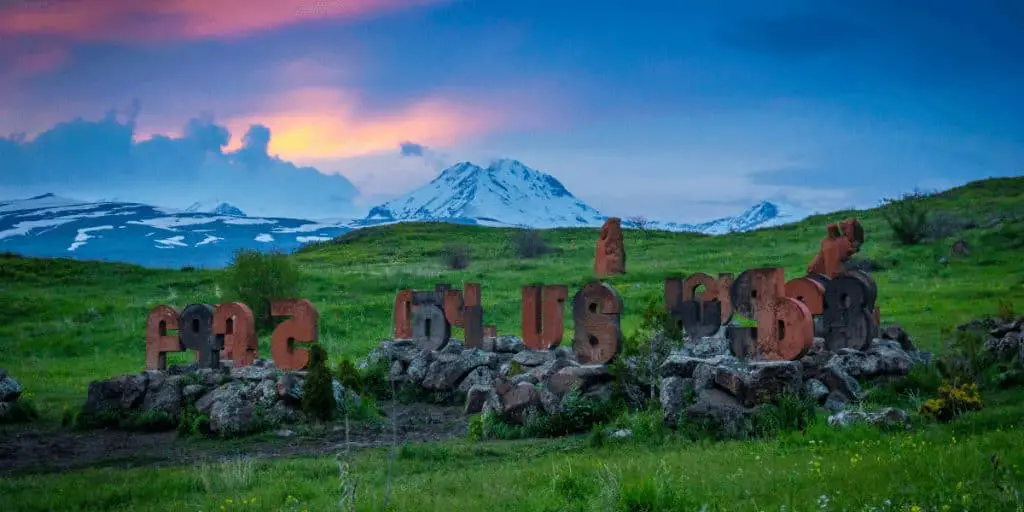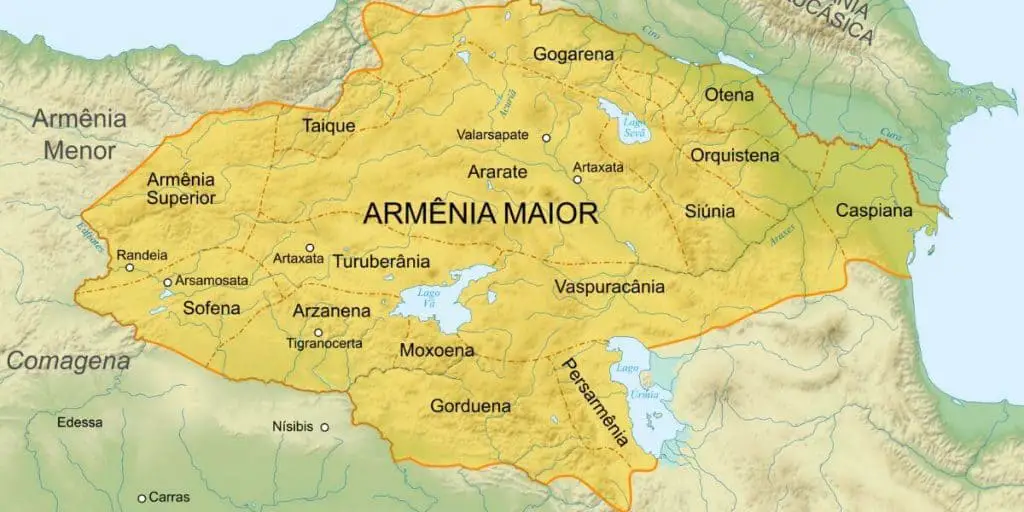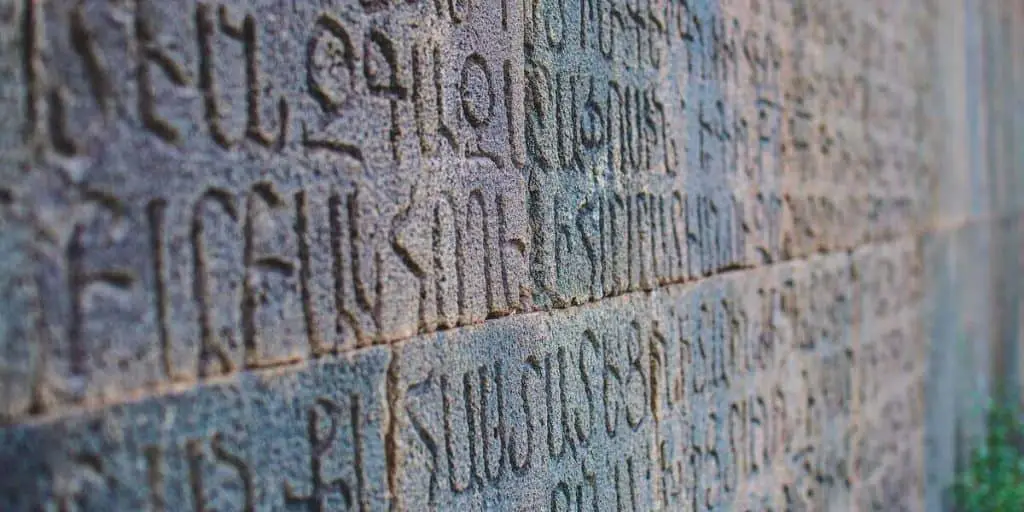This post about Armenian language is for true language enthusiasts. And if you’re one of them, it will give you a basic overview of the history of the Armenian language. We’ll also look into some particularities of the Armenian grammar. And if you like this informative article, ping me on Instagram or Twitter, with #ArmeniaTravelTips and I’ll cover this topic in more details.
How difficult is the Armenian language?
The Armenian language can be considered a complex one due to various historic and cultural reasons. It’s a fairly difficult language to learn, mainly for two reasons. First, it is a very old language that has maintained many of its archaic forms. In fact, the first traces of the Armenian alphabet are found in BC. Second, the classical Armenian language that’s taught in textbooks is almost never spoken by Armenians in everyday life. The natives in Armenia use its colloquial form. So, it’s very difficult to practice Armenian when you learn it as a foreigner. If you look just at the surnames, you will notice that there are quite a few weird Armenian surnames which tells the language has evolved through many ages.
The fact is: Armenian is difficult to learn. And it is true not only for English speakers but also for every other language native. This is because Armenian is a language isolate. Although it belongs to the Indo-European family of languages, there is no other actively used language that would be close to it.
The US Department of State, or to be precise its Foreign Services Institute, classifies Armenian under category III, i.e. among the hardest languages for English speakers. They say, one would need about 1100 classroom hours to be able to speak Armenian. Yes, that’s a lot!
Linguists have been arguing for a long time about which branch of the Indo-European family of languages Armenian belongs to. It is really so different from all the other languages out there that it’s a matter of serious discussion. Now we can say with confidence that it belongs to the Eastern branch of the Indo-European family. This family also includes Aryan, Greek, Balto-Slavic and some ancient languages of the Balkans.
Armenian is the state language of two countries: the Republic of Armenia and the de-facto Republic of Artsakh (known as Kharabakh). Today, the total number of speakers of the Armenian language around the world is estimated at 6.4 million. Outside Armenia and Artsakh this language is widely spoken by Armenians living abroad. So you can come across this language in countries like the USA, Russia, France, Georgia, Iran, Lebanon and many others. All of them have a strong Armenian presence in the form of local diaspora communities.
The 3 Versions of the Armenian Language
Linguistically, there are 3 versions of the Armenian:
- Old Armenian, aka Grabar – literary written language
- Western Armenian, which was used in Western Armenia, now Turkey. And now it is the language of the multi-million Armenian diaspora in Europe and America
- Eastern Armenian, spoken by the Armenians of the post-Soviet space, Armenia, Iran. Armenians use literary Armenian on television, official events, and teach it in schools.
And what’s interesting is that above all these branches, the language has many dialects. Quite literally, almost every town or region has its special dialect. These differ from each other with not only the vocabulary but also the pronunciation and phonetics.
The difference between the western (USA, Mediterranean) and eastern (Armenia, Iran) versions of the new literary Armenian language is noted at all levels, especially phonetic.
Phonetically the eastern version is closer to the Grabar, but the interesting part is that the unified graphics and spelling provide mutual understanding of the speakers of both variants. The main difference is that in the western version there was a secondary stunning of voiced explosive consonants: b, d, g switched to p, t, k. So two carriers of different versions will pronounce the same word differently.
The Ancient Armenian language
Even before the creation of the Armenian alphabet in the 5th century, the local people were speaking the ancient Armenian language. This form of the language is preserved in written sources and it is called Classical Armenian or Grabar. With the appearance of the first monuments in the 5th century AD, Armenian writings appear, the foundations of which were laid by Mesrop Mashtots.

As a literary language, Grabar lasted until the beginning of the 19th century. Grabar was also used to be the unifying component for people speaking different dialects when at the beginning of the 20th century it was taught in schools. In the Armenian Apostolic and Catholic Church, Grabar is still used today as a liturgical language. The clergy heavily influenced the development and processing of this literary language. Having reached a certain level, Grabar was stopped in development, and the Armenian folk speech continued to freely develop and transform just like any other living organism.
As of now, the Armenian language has a very rich vocabulary with many words that are difficult to remember and many of them can even have 8-10 synonyms.
What does the grammar look like? Let’s take a deeper look!
The Armenian grammar is really rich and complex. It has the following parts of speech: nouns, adjectives, verbs, pronouns, numerals, adverbs, prepositions and postpositions, conjunctions, modal words, and interjections. Here are some key highlights of the Armenian grammar:
- Nouns don’t have a grammatical gender. They have 2 forms of numbers: singular and plural.
- Numerals reflect the decimal system of counting, going back to the Indo-European root fund.
- There are no grammatical categories. But there are 7 cases (according to some other classifications – 5) and 8 types of declension.
- Adjectives are not consistent with nouns.
- As to pronouns, almost all Indo-European pronouns were preserved and none of them has a grammatical gender.
- The verb has the following categories: 3 voices (passive, active and neutral), 3 persons, 2 numbers, 5 moods (indicative, imperative, infinitive, potential or conditional, subjunctive), and 3 tenses (present, past, future).
- The word order is free, but usually in the first place is a group of a subject, then predicate, further circumstances.
And to wrap this up,
Even this surface-level info shows the complexity of Armenian. Even the word Armenia has multiple theories and speculations around it. The native speakers can comparatively easily learn romano-germanic, slavic, and many other languages of the Indo-European language family. What usually causes us problems in other languages is the concept of gender for verbs and adjectives, which we don’t have in our native tongue.
The Armenian language is nowhere near to any other one that’s out there, among 7000 written and spoken languages in the world. You will surely enjoy learning a couple of words in this language. 😉 Check out my post about weird Armenian phrases and some funny Armenian insults for a good laugh. And also this one if you want to learn some tips and useful phrases in Armenian. Anyway, even if you don’t know Armenian and know some Russian, that’s fine for traveling in Armenia. Find out “Why do Armenians know Russian” in my blog post.
If you are a language nerd like me and find this article informative, please reach out and share thoughts and ideas with me on Instagram or Twitter, with #ArmeniaTravelTips. I’d love to get into a nice discussion on linguistics!
Featured image credits: Antimion on Wikimedia Commons (CC)





